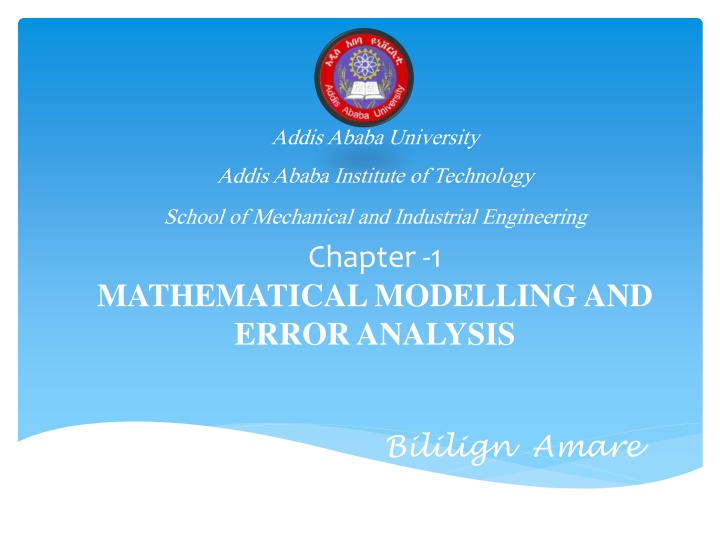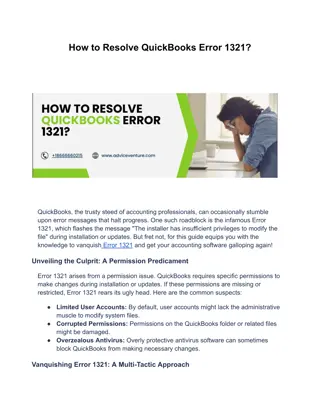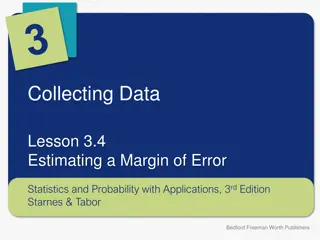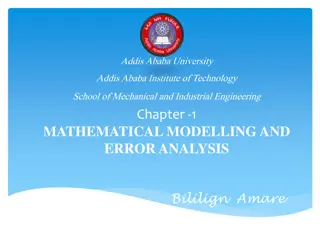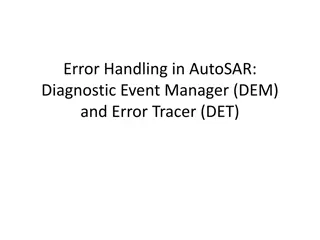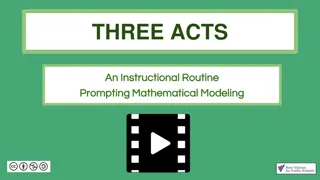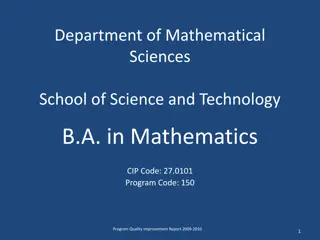Mathematical Modeling and Error Analysis in Engineering
Mathematical modeling plays a crucial role in solving engineering problems efficiently. Numerical methods are powerful tools essential for problem-solving and learning. This chapter explores the importance of studying numerical methods, the concept of mathematical modeling, and the evaluation process in modeling. Through mathematical language and equations, systems' behaviors are described, reflecting the state of the system based on variables, parameters, and forcing functions.
Download Presentation

Please find below an Image/Link to download the presentation.
The content on the website is provided AS IS for your information and personal use only. It may not be sold, licensed, or shared on other websites without obtaining consent from the author.If you encounter any issues during the download, it is possible that the publisher has removed the file from their server.
You are allowed to download the files provided on this website for personal or commercial use, subject to the condition that they are used lawfully. All files are the property of their respective owners.
The content on the website is provided AS IS for your information and personal use only. It may not be sold, licensed, or shared on other websites without obtaining consent from the author.
E N D
Presentation Transcript
Addis Ababa University Addis Ababa Institute of Technology School of Mechanical and Industrial Engineering Chapter -1 MATHEMATICAL MODELLING AND ERROR ANALYSIS Bililign Amare
INTRODUCTION methods are Numerical mathematical problems are formulated so that they can be solved with arithmetic operations. Although there are many kinds of numerical methods, they have common characteristics: they invariably involve large numbers calculations. It is little wonder that with the development of fast, efficient digital computers, the role of numerical methods in engineering problem solving has increased dramatically in recent years. techniques by which of tedious arithmetic
The reasons why we should study numerical methods are: Numerical methods are extremely powerful problem solving tools. To use commercially available prepackaged, or canned , computer numerical methods. Many problems cannot be appreciated using canned programs. They are efficient vehicles for learning to use computers. They provide a vehicle for you to reinforce your understanding of mathematics. programs that involve
Mathematical Modeling A mathematical model is an abstract model that uses mathematical language to describe the behavior of a physical system. Mathematical models are used in extensively Natural sciences and engineering disciplines (such as physics, biology, mechanical and electrical engineering) In the social sciences (such as economics, sociology and political science); Physicists, engineers, computer scientists, and economists. A mathematical model usually describes a system by a set of variables and a set of equations that establish relationships between the variables.
A mathematical model can be represented as a functional relationship of the form Dependent variable = f( independent variables, parameters, forcing functions) The dependent (state) variable is a characteristic that usually reflects the behavior or state of the system. The independent (decision) variables are usually dimensions such as time and space, along which the system s behavior is determined. The parameters (constants) are reflective of the system s properties or composition. The forcing functions are external influences acting up on the system. a=F/m a= the dependent variable reflecting the system s behavior. F= the forcing function & m=a parameter representing property of the system.
Model evaluation An important part of the modeling process is the evaluation of an acquired model. How do we know if a mathematical model describes the system well? How do we know that the measurement data are a representative set of possible values? Does the model describe well the properties of the system between the measurement data (interpolation)? Does the model describe well events outside the measurement data (extrapolation)? A common approach is to split the measured data into two parts; training data and verification data. The training data are used to train the model, that is, to estimate the model parameters. The verification data are used to evaluate model performance. If the model describes the verification data well, then the model describes the real system well.
COMPUTER PROGRAMS Computer programs are merely a set of instructions that direct the computer to perform a certain task. Two types of software users are: Those who take what they have given. Who can grow and become a "power user" by learning to write computer program for solving specific problems. In this course you will write MATLAB M-files to perform engineering-oriented numerical calculations. MATLAB was originally developed as a matrix laboratory. To this day, the major element of MATLAB is still the matrix.
ERROR ANALYSIS Numerical techniques yield estimate that are close to the exact analytical solution, there could be discrepancy, or error, because the numerical method involve an approximation. If analyticalsolution is available it helps to compute the error exactly. For many applied engineering problems, we cannot obtain analytical solutions. In these cases, we must settle for approximations or estimates of the errors. SIGNIFICANT FIGURES Significant figure, or digit, has been developed to formally designate the reliability of a numerical value. Example discuss the number of significant digit for the given numbers 0.001234 0.0001234 1.234x10^-9 0.00104561 0.0012345 0.000123456
ACCURACY AND PRECISION The errors associated with both calculations and measurements can be characterized with regard to their accuracy and precision. Accuracy refers to how closely a computed or measured value agrees with the true value. Precision refers to how closely individual computed or measured values agree with each other.
Numerical errors arise from the use of approximations to represent exact mathematical operations and quantities. Truncation errors, which result when approximations are used to represent exact mathematical procedures, and Round-off errors, which result when numbers having limited significant figures are used to represent exact numbers. True value= approximation + error Et = true value approximation Where, Et is true error ???? ????? ???? ????? 100% Where, ??is true percent relative error ??????????? ????? ????????????? Where, ??is approximate percent error ??????? ????????????? ???????? ????????????? ??????? ????????????? ?? = ?? = 100% ?? = 100% l??l<??Where, Es is pre-specified error
